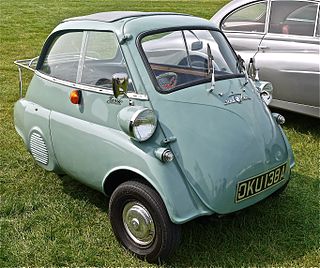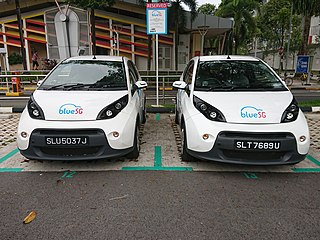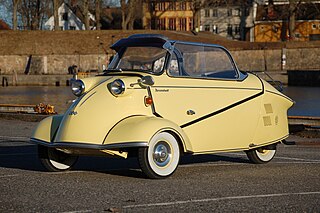
The Isetta is an Italian-designed microcar built under license in a number of different countries, including Argentina, Spain, Belgium, France, Brazil, Germany, and the United Kingdom. Because of its egg shape and bubble-like windows, it became known as a bubble car, a name also given to other similar vehicles.
Rinspeed Inc. is a Swiss concept car builder and mobility visionary. Since 1991, they have also designed exotic concepts and special vehicles for the CES in Las Vegas, the Geneva Motor Show and other car shows each year, but do not enter into production.

The Fend Flitzer was a three-wheeled invalid carriage designed and built by Fritz Fend. The Flitzer established many of the basic concepts on which Fend's later Messerschmitt Kabinenroller microcars were developed.

Carsharing or car sharing or car clubs (UK) is a model of car rental where people rent cars for short periods of time, often by the hour. It differs from traditional car rental in that the owners of the cars are often private individuals themselves, and the carsharing facilitator is generally distinct from the car owner. Carsharing is part of a larger trend of shared mobility.

The Messerschmitt KR200, or Kabinenroller, is a three-wheeled bubble car designed by the aircraft engineer Fritz Fend and produced in the factory of the German aircraft manufacturer Messerschmitt from 1955 until 1964.

The Messerschmitt Kabinenroller was a series of microcars made by RSM Messerschmitt from 1953 to 1956 and by Fahrzeug- und Maschinenbau GmbH, Regensburg (FMR) from 1956 to 1964. All the Messerschmitt and FMR production cars used the Kabinenroller's monocoque structure, featuring tandem seating and usually a bubble canopy.

The FMR Tg500 was a sports car built by Fahrzeug- und Maschinenbau GmbH, Regensburg (FMR) from 1958 to 1961. Based on the Messerschmitt Kabinenroller monocoque, which otherwise was a platform for three-wheelers, the Tg500 was a four-wheeled car with a two-stroke straight-two engine. FMR had taken over production of the KR200 from Messerschmitt in 1956. While the KR200 still used the Messerschmitt name and logo, the Tg500 was badged as an FMR.

The Messerschmitt KR175 microcar (1953–1955) was the first vehicle built by Messerschmitt under its 1952 agreement with Fritz Fend. In concept, although not in actual design, it was an extended version of the Fend Flitzer invalid carriage. Approximately 15,000 were built before it was replaced by the Messerschmitt KR200 in 1956.

A mobility scooter is an electric vehicle and mobility aid equivalent or auxiliary to a power wheelchair but configured like a motorscooter. When motorized they are commonly referred to as a power-operated vehicle/scooter, handicap scooters, or electric scooter as well. Non-motorized mobility scooters are less common, but are intended for the estimated 60% of wheelchair users who have at least some use of their legs.

Miles Electric Vehicles was a manufacturer and distributor of all-electric vehicles manufactured by FAW Tianjin in China that met international car safety standards. Miles was given the "Electric Car Company of 2007" award by Good Clean Tech. The company filed for bankruptcy on June 11, 2013.

A wheelchair is a chair with wheels, used when walking is difficult or impossible due to illness, injury, problems related to old age, or disability. These can include spinal cord injuries, cerebral palsy, brain injury, osteogenesis imperfecta, motor neurone disease, multiple sclerosis, muscular dystrophy, spina bifida, and more.

A motorized wheelchair, powerchair, electric wheelchair or electric-powered wheelchair (EPW) is a wheelchair that is propelled by means of an electric motor rather than manual power. Motorized wheelchairs are useful for those unable to propel a manual wheelchair or who may need to use a wheelchair for distances or over terrain which would be fatiguing in a manual wheelchair. They may also be used not just by people with 'traditional' mobility impairments, but also by people with cardiovascular and fatigue-based conditions.

The CityCar or MIT CityCar is an urban all-electric concept car designed at the Massachusetts Institute of Technology Media Lab. The project was conceived by William J. Mitchell and his Smart Cities Research Group. It is now led by Kent Larson, Director of the Changing Places Research Group at the Media Lab. The project came into reality in 2003 under the support of General Motors. Time magazine choose the CityCar to be one of the "Best Inventions of 2007".

The Vehicle Production Group LLC was an American automobile manufacturer. Based in Miami, Florida, it made the wheelchair-accessible taxicabs, the MV-1, which was built in Mishawaka, Indiana at an AM General plant.

Invalid carriages were usually single seater road vehicles, buggies, or self-propelled vehicles for disabled people. They pre-dated the electric mobility scooters and from the 1920s were generally powered by a small gasoline/petrol engine, although some were battery powered. They were usually designed without foot-operated controls.

The Canta is a two-seat handicaped vechicle from the Netherlands specifically created for disabled drivers. It was developed in 1995 by Waaijenberg together with the Delft University of Technology. In addition to the standard petrol-engined production models, an electric Canta was designed for the German market but it has remained at the prototype stage. In the Netherlands, it is classified as a mobility aid because the width of the vehicle is only 1.10 metres, thus it may - unlike larger microcars - be used on cycle paths as well as sidewalks and footpaths; in addition a driver's license is not required.

The Chairiot solo is a wheelchair accessible microcar manufactured by Chairiot Mobility Inc. It is one of the few cars for wheelchair users designed specifically for that purpose, and not a conversion.

Micromobility refers to a range of small, lightweight vehicles operating at speeds typically below 25 km/h (15 mph) and driven by users personally. Micromobility devices include bicycles, e-bikes, electric scooters, electric skateboards, shared bicycles, and electric pedal assisted (pedelec) bicycles.

The Microlino is an all-electric, space saving, lightweight four-wheeled vehicle produced by Micro Mobility Systems, designed for urban mobility. Its key feature is the front opening door, inspired by the bubble cars from the late 1950s, which enables users to get out directly onto the pavement after parking. The vehicle has two seats, a trunk, a folding sunroof and can be charged with either a household or a type 2 plug. The Microlino is legally designated and functionally intended as a lightweight quadricycle (L7e). It aims to combine the advantages of both a car and a motorcycle. Due to the "reduce to the max" approach in the engineering, the Microlino has 50% less parts than a regular car, weighing 513 kilograms and consuming less energy when driving.




















